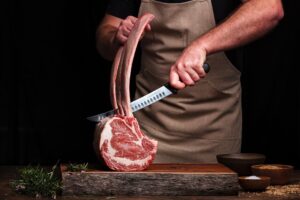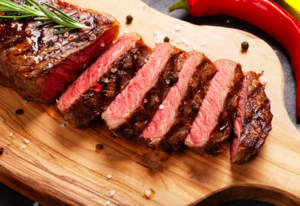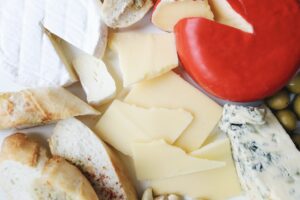Sous vide is the secret of the chef at top restaurants. They create the best tender, juicy and flavorful dishes by this amazing technique. And now you can also cook fabulously at home. Here is a complete guide for you about what and how to sous vide. Let’s dive in!
Table of Contents
What is Sous Vide?
Sous vide means “under vacuum” in French, and refers to the process of vacuum-sealing food in a plastic bag. Then, boil the vacuum-packed food item in a water bath at a low temperature for a long time. The temperature is controlled precisely and constantly by the sous vide cooking machine. Under precise temperature control, the item is cooked evenly with a desired doneness, and thus, getting the best result.
Sous vide is recently getting popular with home cooks, but not a new technique, though. Restaurants have been using it for years to create consistent and high-quality results. This technique owes its popularity to the fact that it provides unparalleled temperature control, and hence, results and textures that are impossible to achieve using traditional cooking methods.
Why Sous Vide? 8 Benefits of Sous Vide Cooking
This French technique has immense benefits to offer over the traditional style of cooking. Sous vide entering home cooking is no less than revolutionary.
Let’s go over the benefits one-by-one and how they are here to change lives:
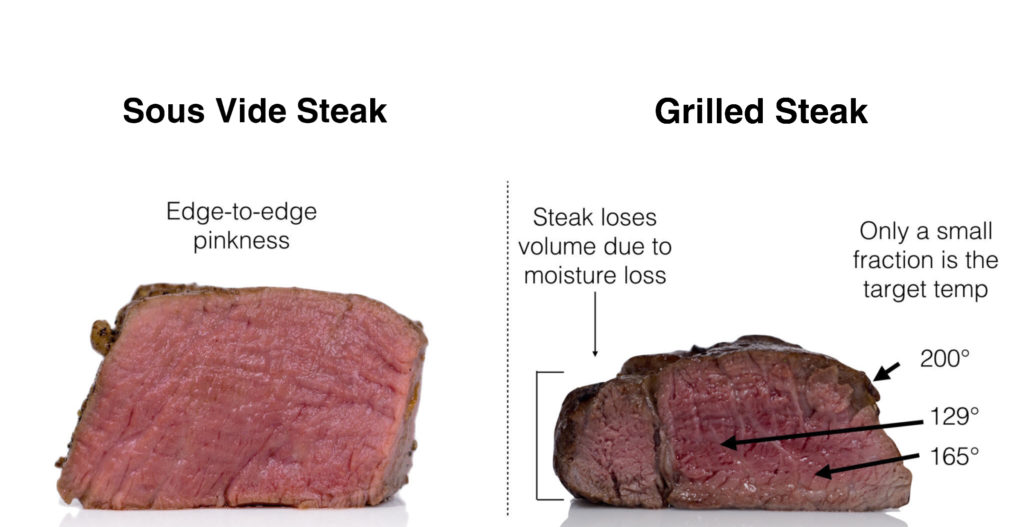
1. Precise Temperature Control
No matter which you use, the water oven or the immersion circulator, they are both advanced. With them, you are able to cook food at a precise temperature for a precise duration. Thus, get the ideal result. They guarantee that no overcooking would happen as well as no failure on achieving the desired doneness.
Also, you see, sometimes you follow the exact MasterChef recipe and end up getting upside-down results. Yes, that’s the heat that made the difference. With the sous vide technique, you know what you are doing. Because you exactly set the temperature and duration, and there is no way it ends up different from your MasterChef results. And if you love the outcome of this time, you can duplicate it next time perfectly and easily.
2. Cook Evenly
Maybe you cook your steak on a grill with your desired temperature using a probe thermometer. But you cannot cook a steak evenly, part of the steak would be overcooked while other parts may be undercooked. This feature is especially great for cooking large pieces of food. With sous vide, the entire steak is cooked with evenly distributed heat, and hence giving a perfect result!
3. Unprecedented Flavor
As the ingredients are vacuum-sealed in plastic bags, they have no contact with water or air. As a result, there is no dilution or evaporation, all the moisture and juices are kept inside. When meat and vegetables cook in their own juices and seasonings without any water added, it creates an intensified, mouth-watering flavor that is unachievable otherwise.
4. Save Money by Tenderizing
Who doesn’t like juicy and tender meat over tough and chewy meat? However, the tender cuts are usually much more expensive.
Cooking meat at consistent, low temperatures for a prolonged cooking time gives deliciously juicy and tender results. Food is cooked better at slow, steady temperatures. Heat goes right inside the meat, without drying out or desiccating the outside. Take steak, for example. Traditionally cooked steak loses 40% of its volume, while with sous vide, you get to retain the juices.
This technique can be used on tough meats to tenderize them by breaking down the muscle tissues. That is to say, the tougher cuts that generally cost you less could be cooked nicely by sous vide. So it saves you money!
5. Save Time
With Sous vide cooking technique, there is no way to get it wrong or messy. All you have to do is grab your ingredients in the right amount and let them cook. No supervision, no undivided attention needed. You carry on with your chores, and meanwhile, your food cooks itself.
6. More Nutritious
As mentioned in the above, the sealed ingredients would not be exposed to the water. Hence, the water-soluble minerals, vitamins or other nutrients are not leached and lost. Also, the low cooking temperature destroys less nutrients than traditional cooking. According to some research, sous vide cooking has the highest retention rate of vitamins when compared with boiling and steaming.
7. Easy Cleanup
After sous vide, just take out the cooked food from the sealed plastic bag and dish it up on a plate. Then, what you need to clean is just a pot that contains boiled water but not anything greasy or sticky.
8. Easy Storage
As the sous vide foods are vacuum-sealed, you can directly plop it into the fridge or freezer instead of using extra containers if you do not eat them immediately. The foods have no contact with air and the bacterial growth is reduced. Hence, it extends shelf life and keeps the freshness of foods well. This is insanely convenient for meal prep!
What Equipment Do I Need to Cook Sous Vide?
Sous vide is more of a technique actually; it used to be, at least. But now, you can avail full-fledged sous vide devices with everything that you need built-in. There is no need to get your hands on a list of equipment to get started. It has become more affordable as well.
You’ll need a few things:
- Sous vide precision cooking device
- A pot or a container to hold heated water (for Immersion Circulator)
- Packaging: vacuum sealing bags, canning jars etc.
- Other accessories if needed
1. Sous Vide Machine
Many types and configurations of sous vide machines have invaded the market with their competitive easy-to-use features. Mainly there are two major types of Sous Vide cookers that you can choose from:
a) Sous Vide Water Oven

Sous vide water oven is a fully contained, all-in-one device. The heat is distributed evenly by natural convection. Most of them cost you a fortune since they need no assemblage or accessories to get started. Not even the container or pot! The only thing you need is a resealable plastic bag, and you are ready to go.
There is one downside to water ovens. They occupy more space on the countertop as they are the size of an oven. This may not be ideal for limited counter space.
b) Sous Vide Immersion Circulator

A standalone immersion circulator heats water in a container and circulates it around for even heating. They are very friendly with your budget and kitchen space since they don’t come with inbuilt water baths. The real beauty of an immersion circulator is that it goes with any pot you already own; clamp on and let it do its job.
The drawback is you need to prepare more accessories like a pot or container, while the heat retention of the container is usually poorer than that of water ovens.
► We ranked the best 10 HERE!
2. Sous Vide Container / Lid

If you are going with the sous vide immersion circulator, you need to prepare a water container or pot as well. Almost any of the pots you already own can suffice for sous vide steak for one person. But for having company over and to cook a whole batch, you need a bigger water container.
Yet, you cannot cover your own pot with a lid tightly if using the immersion circulator as it’s extended out of the pot. This will lead to great heat loss and water evaporation. Hence, consuming more energy as well as the water level may be lower than the minimum level of the sous vide cooker which could cause poor performance. This can be solved by purchasing a container or lid that is tailor-made for sous vide. Or you could use plastic stretch wrap to cover instead of a lid.
3. Sous Vide Packaging

Packaging of the food items or the ingredients plays a major part in getting the quality and texture of cooked food. Retaining moisture is the key to that signature restaurant taste. And proper packaging is what makes sure all the juices and flavors are infused in the meat.
The most suggested for optimum results is you use a vacuum sealing bag. If the food is allowed to lose moisture or is made into contact with water, you are getting a boiled dinner! Do make sure you read the packaging of the bags before you buy. They should be food-grade BPA-free bags. Also, some bags are reusable and that are more eco-friendly.
However, using vacuum sealing bags needs a vacuum sealer which costs you more money and space in the cupboard. Zip lock bags with an air valve can be a replacement, especially for the first few times of sous vide cooking, invest less and do the trial first.
Alternatively, you can vacuum a regular zip lock bag (does not have an air valve) without a vacuum sealer. To do so, you need a pot of water. Firstly, put your food inside the bag and partially seal it. Then, slowly submerge the bag in the water and the air will be pushed out due to the water pressure. Finally, zip your bag carefully, and it’s done. This is called water displacement method, you may refer to the video below:
For the food with a large amount of liquid or something like beans, grains and pudding, a jelly jar could help.
4. Other Accessories
a) Rack

This is especially for water ovens and cooking several food items at the same time. Since the heat is distributed by convection in water ovens, a rack could assure the bags are separated and heated evenly.
b) Clip / Weight

A well-vacuum-sealed bag will sink normally. However, the circulated water may bring the plastic bag up and down which could lead to a poor cooking performance. Using clips or a food safe weight could fix it.
c) Pan / Grill Pan / Searing Torch

For that final color, crust, taste, and texture, you need to sear your meal by bringing it in direct contact with high temperature for a while. A cast iron pan or grill pan will be just fine. However, investing in a searing torch won’t be bad either.
Top 10 Sous Vide Cookers in 2022 At a Glance
◈ Best Overall: Anova AN500-US00 Precision Cooker [Original] (1000W)
◈ Best Powerful: Anova Precision Cooker Pro (1200W)
◈ Best Connectivity: Breville CS20001 Joule Sous Vide Cooker (1100W)
◈ Best Temp Control: Inkbird Sous Vide Cooker (1000W)
◈ Best Accurate: Wancle Sous Vide Immersion Circulator (850W)
◈ Best Budget: Fityou Precision Cooker (1100W)
◈ Best Value: Yedi Infinity Sous Vide Cooker (1000W)
◈ Best Quiet: Kitchen Boss Sous Vide Cooker (1100W)
◈ Best Mini: Anova Precision Cooker Nano (750W)
◈ Best Design: KitchenFun Precision Cooker (1100W)
► Read More: 10 Best Sous Vide Cooker for 2022 | Top Pick of Immersion Circulator
3 Simple Steps to Sous Vide
Here are 3 easy steps for how you sous vide :
Step 1: Preheat Precision Cooker
If you use a water oven, just fill it with water. If you use an immersion circulator, fill a pot with water and attach the circulator to it. Then, set the level of temperature and time for the desired level of doneness.
Step 2: Seal Bags
You may use a vacuum sealer to put the air out. Or if you use a zip lock bag instead, just draw the air out by a pump which is usually included when you shop for it. And then put the bags into the preheated water.
Step 3: Put the Finishing Touches
Enjoy your meal with a quality restaurant-style texture. Don’t forget to add the final touches, such as searing or grilling.
Sous Vide vs Slow Cooker Cooking
Both of them are kind of slow cooking. They all cook at a low temperature for a long time. So what’s the difference? The main difference is that sous vide requires a vacuum condition. Hence, it produces some disparities in terms of the outcome.
In slow cookers, the flavors and juices of individual ingredients tend to permeate the whole dish. While sous vide offers the option of compartmentalizing them.
Moreover, sous vide cookers offer little chance of overcooking. While vegetables may end up overcooked and drained with slow cookers.
► You may want to take a look at this post: Slow Cooker Cooking Beginner’s Guide
What is the Best Food to Cook Sous Vide?
Anything that you want to cook without hours of supervision and going off track from the actual recipe, sous vide is there at your service. Steak, pork chop, chicken breast, salmon, poached egg, vegetables, dessert…Absolutely anything!
Food Safety Tips for Sous Vide Cooking
1. Never Cook Food Below 130°F
It is only at temperatures above 130°F (54.4°C) that bacteria begin to die. Below this temperature, you can at most stop them from growing, but they don’t die. This range of temperature from around 4.4-54.4°C is referred to as a danger zone. So never cook below 130°F which may cause diarrhea or other diseases.
2. Check the Temperature Calibration Every Few Weeks
Although the latest cooking devices are very precise, and their calibrations do not vary over time. We suggest you double-check the temperature of your circulator every few weeks just to make sure.
3. Cook by Thickness
Trim and cut the ingredients well, especially meat. The meat of more than a certain thickness may not be pasteurized at the temperature where the rest of the meat gets cooked well. Less than 2-inch thickness is a practical maximum thickness.
7 Cooking Tips for Sous Vide Cooking
1. Cover the water bath
Remember to close the lid of your water oven. If you are using an immersion circulator, cover the container with a lid or a plastic stretch wrap. This is to minimize the impact of heat loss and water evaporation as they are heated. Since sous vide cooking takes a longer time. After hours, the water evaporates and if the depth of water is lower than the heating coils, it would cause damage. Covering the water bath could solve.
2. Ensure the bags are sealed tightly
Before sous vide your food, make sure the plastic bags are vacuum-sealed tightly. Otherwise, they are not sous vide but boiling if the food contacts with water. And if there are air gaps, they may cause uneven cooking. This is because air is a poor heat conductor, so the heat energy could not be conducted to the food item well. Therefore, it’s important to remove all the air out of the bag.
However, for soft and fleshy foods like fish filets, do not over tighten them. Stop vacuum-seal the bag before compressing the flesh.
3. Ensure the bags are fully immersed in water
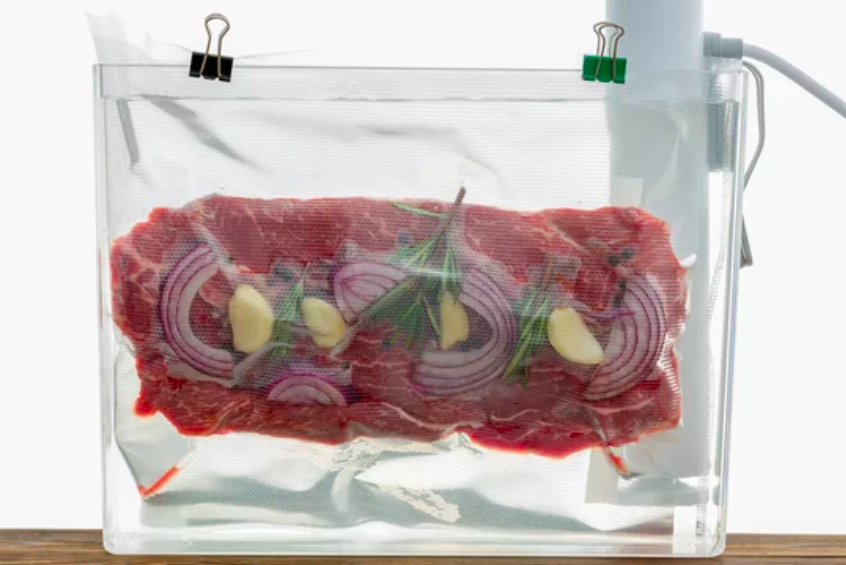
Obviously, food cannot be sous vide well if the bags are not fully immersed in water. Bags would sink under normal circumstances. Yet, they will float on water on condition that air gaps appear in the bags. Other than that, sometimes the circulator would push the bags up and down too.
To solve this issue, you can use clips or a food safe weight to fix their position.
4. Thaw beforehand
As you have seen, the danger zone for bacteria is pretty wide. When you put frozen, icy ingredients in a water bath, they tend to remain in the danger zone for a long time. This gives the bacteria in the food a chance to flourish.
Also, the required time may be longer than the duration stated in the recipe if the ingredients are frozen. To achieve the best result, make sure you thaw before sous vide.
5. Pay attention to seasonings
The flavor and aroma of seasonings would be intensified under a vacuum condition and long time cooking. Therefore, beware of the types and amount of herbs and seasonings. Some may have a strong taste originally, so it’s better to reduce the quantity compared to traditional cooking.
6. Sear the food after sous vide
Sous vide cooks your food just fine, retaining the flavor, texture, and juices. But for a deep, classic caramelized flavor, brown your cooked meal on a pan over direct heat. Sear or grill your meat and sautéed the vegetables could make them look more appetizing.
7. Watch the wine
Wine always brings a dish to the next level, but be careful when it comes to sous vide. Since you will use a vacuum-sealed bag and hence, there is no room for liquids to evaporate and escape. The best way to sous vide with alcohol is to reduce the amount of it.
8. Freeze if the food is with a lot of sauce
For recipes with a lot of sauce, for example, Korean spicy beef ribs, it’s not easy to vacuum seal properly. To prevent leaking, you can freeze the ribs with sauce into ice, then vacuum seal in plastic bags. But once again, remember to defrost the food items before putting them into a sous vide precision cooker.
Summary
You have a complete account of sous vide cooking, its technique, and the available equipment. Since it is now entering home cooking, we are able to appreciate how far it is going to take cooking in terms of quality and effort-economy, which is something to die for in this busy era.
Give this French cooking technique a shot. And see if it goes in line with your lifestyle and taste buds!

